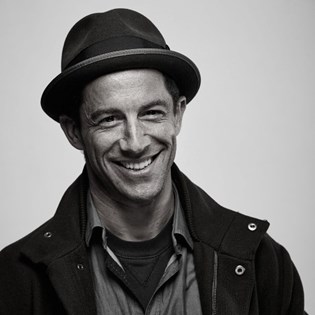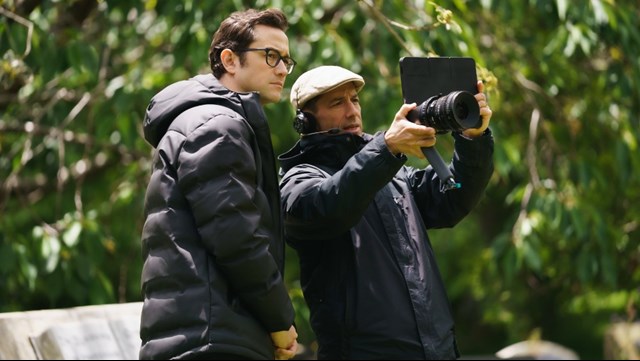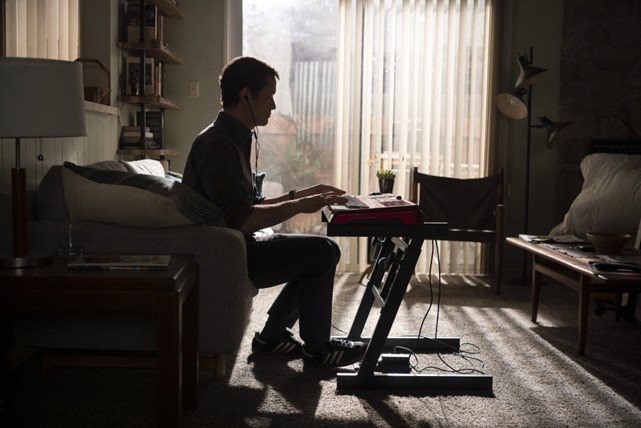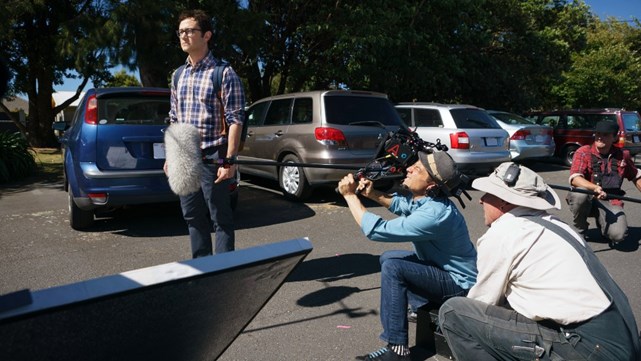by Edward Douglas, Below The Line
Joseph Gordon-Levitt has been working in television and film, on both sides of the camera, for his entire life, and his new Apple TV+ series, Mr. Corman, is the culmination of all his artistic endeavors. In the show debuting on Friday, August 6, Gordon-Levitt plays the title character, an L.A. elementary school teacher facing multiple personal crises, often with the help of his equally angsty roommate Victor (Arturo Castro).
The show is shot by Gordon-Levitt’s long-time collaborator, Cinematographer Jaron Presant ASC, who has worked his way up the camera chain from being a gaffer on Gordon-Levitt’s 2005 indie noir, Brick, the directorial debut by Rian Johnson, and then working on many of Gordon-Levitt and Johnson’s projects since then.
Presant and Gordon-Levitt have given Mr. Corman quite a unique look from other television series, and in a recent phone conversation, Below the Line spoke to Present about the nuts and bolts of making a series that looks so artistic and unlike anything else on TV (or even Apple TV). Here at Below the Line, we often talk about Cinematographers/Directors of Photographers as artists, but Presant is just as much a scientist in the way he’s created ways of matching light between outdoor locations and stages (even in different countries!) and even created an algorithm to make dolly shots look and feel more handheld.

Jaron Presant ASC
Below the Line: Obviously, you’ve known Joe for a long time, as you’ve risen through the camera ranks on his movies and those with Rian Johnson, so what led up to the show, Mr. Corman?
Jaron Presant: I’ve known Joe since Brick. I was the gaffer on Brick, and did a second unit on Brick, and that kind of started me shooting second unit for Rian, and then as Rian’s movies got larger, the second unit got larger. The way that he uses that unit is kind of like a mini main unit where he bounces between the two units, so it’s a really fun process, and one, which literally, I’m doing right as we speak. That’s where I met Joe and going on from there. He has a production company that is like a geographically decentralized crowdsourced production company, where the community creates content that then the community re-edits and the community creates into products, whether it’s short films or albums or books. He did a TV show version of that production company, and that concept, called HitRecord on TV, and I shot that with him, and I also shot additional photography on his movie Don Jon, and then this is our third project.
BTL: Was it kind of organic to move onto Mr. Corman and was that something Joe had been developing for a while before you got involved?
Presant: I know he’d been working on it for a good time, but I wasn’t involved in all of his development stuff. By the time I got involved, it was already going with Apple.
BTL: When he comes to you with this project, what’s the first thing you two talk about? Does he have scripts for all ten episodes? He didn’t write all ten episodes, I don’t think.
Presant: No, he didn’t. He had rough concepts, but they hadn’t written the whole thing, and he had the idea of it. From a visual standpoint, he wanted the entire thing to feel more like little movies, than for it to be feeling like TV show He didn’t want to shoot it traditionally, he didn’t want it to look traditional. It was very important to him that it had a movie feel. And so, that was kind of the approach we took with everything. In addition to that, what he really wanted it to be was he wanted it to highlight the actors, to let actors act and have the camera be almost another player in the scene, that it’s like a character sitting in the room with the actors. To that effect, the style was one which was going to have very long takes. It wasn’t going to be quick cutting. As much as possible, it would be the actors acting, and the camera not cutting away, and the camera following and moving with the actors as another person would be in the room.
BTL: Was there a lot of talk in advance about shots or storyboarding before getting to set?
Presant: Conceptually, our approach to this was unlike any other show that I’ve done. Normally, we’ll design shots. We’ll get really specific, and then we’ll go into a space, and maybe there’s a little bit of modification based on a space or on actors’ movements. But it’s pretty much what we design is what we shoot. In this one, our process was, we would start out going through the script, and we’d hit all the core emotional beats that were important to Joe. We’d isolate those, and then I’d go away and come up with a shot design, that then I’d pitch back to him, but then we would go back and forth through the process. Some of the ideas would hit, and some of the ideas wouldn’t, and we’d go back and forth and keep tweaking the design of the shots.
But then, when we got to set, that would be like a guide map. The actors would come in, and it would be a very open process where the actors would start going through the scene. It was just the actors, myself, and the camera operators and our first AD, and it was a closed rehearsal where there was this free flow of ideas back and forth from everybody. That shot design we did served as the guide map for that process, but we let it be very open. We kind of modeled it on a prototyping model, where you try to keep things as fluid as possible as late in the game as possible. So, the core seeds were there, and the seeds of the shot design wouldn’t change. If the camera was going to be an interactive camera that followed throughout the apartment, that core idea and those core beats that Joe and I identified really early on, those would never change. The concept behind the shots wouldn’t change, so if there was some visual concept that we wanted to find ourselves in at some point in the shot that it was important to get, we would build into that. Oftentimes, an actor would say, “Well, I was gonna go over here,” and then I would think, “Well, if you were going to go over here, we wanted to move the camera at this point, but what if I moved it a half a page earlier?” And then, that would prompt Joe to say, “If that happens, then we could do this other thing.”

Gordon-Levitt (L) and Jaron Presant on set
All of a sudden, those ideas were going back and forth, and it was almost like a jazz ensemble, which is a very different workflow than anything I’ve ever done before and really, really rewarding. Everyone in the process became really creatively invested, and it’s one of Joe’s massive strengths. He has a way of finding really good people, and then gets them creatively invested, so then the ideas are more of a shared process. He’s still a very specific director who knows exactly what he wants, but he’s really open to ideas and ideas coming from everyone, so the process is really, really incorporative.
BTL: That sounds very different from television in general. In fact, that sounds almost the exact opposite, because in television that would never happen.
Presant: Massively different, right? The funny thing is that just on a superficial level, it’s so different from TV, but also on a deeper level, it’s so different from even movies. To have that kind of interaction on ANY project is really special, and to have it being on a TV project is kind of mind-boggling. It was a really, really special process, and everybody involved could feel it in the space, in the moment, and in the process. It was something really, really special.
BTL: From the episodes I’ve seen, it generally seems to be only Joe and one or two other actors, except for the Halloween party episode, but how did the other director, Aurora Guerrero, work? Did she take the same approach?
Presant: So the way that we did it with Aurora is we prepped her on what the process was and how we went about it and then tried to bring her into that process, relative to her episodes. We did the same type of process with her, though it played a little differently, because obviously, with her, you don’t have the actors in the whole lead-process. When I’m working with Joe, he knows he’s looking at it not only from the directing standpoint, but from the acting standpoint. So Aurora, it kind of became a two-step process because we had the first process where we went through with Aurora and did a very similar thing to what I was just talking about. But then also did another kind of secondary pass with Joe. We took those ideas and went to Joe and then Joe brought in the acting side of it, so it was, again, like a very incorporated process.
BTL: Getting Arturo Castro as part of the cast definitely helped. The episode mainly with him and his daughter [104] was pretty amazing. It’s pretty different also to not have the main character show appear much in an early episode.
Presant: It was great, and Arturo is so good. I mean, he’s such a great actor. That’s also one of the key things that the show is built around, is it has just incredible actors, and we really wanted to let those actors shine. There was a lot of effort put into giving them the flexibility and pointedly not writing off the camera and the lighting, but making those serve a bigger purpose. And so, everything with the shot design is built around being able to have that flexibility for the actors.

BTL: Talking about some of the lighting choices: technically, while you have plenty of light while shooting the daytime exteriors in L.A., the interior of his apartment just didn’t look like it was something built on a stage, because you have what looked like natural sunlight coming through the windows. I couldn’t figure out if that was done on a location.
Presant: Thank you, by the way, I really appreciate that. [laughs] So, the apartment was a set on stage, and one of the things… let’s start conceptually. Conceptually, Joe and I talked a lot about what the quality of light and what the quality of the imagery should be globally on the show. He and I are both from L.A. — for the most part, I’m from Missouri, but grew up in L.A., and he’s straight up from the valley. One of the things we both love about L.A., a lot of people think the valley is kind of mundane, but there are these moments of absolute beauty that pop from the mundane normalcy, where you’re sitting on a road and the road is part of a grid, and it stretches off into the distance, but the sun’s at this perfect spot, and it’s just gorgeous, and hits kind of your soul. That thing, that like beauty of the mundane, is what we really wanted to capture and like embed in every aspect of the show. And so, in terms of light in the apartment, we wanted to embrace flares and the sun being in really nice spots that bounced around the apartment. While the apartment is kind of this really bland apartment, it also has its own kind of beauty to it. The production designer, Meghan Rogers, did just an awesome job with all the design. Even when we went to New Zealand, that changed over, and we changed production designers, but it’s still like all of her design carried so well through.
BTL: When did you shoot in New Zealand? Was that exteriors or all the stage stuff?
Presant: We started the show in LA and then shut down after three weeks of shooting due to the pandemic. Going back to the lighting for a moment, one of the things that I do with my lighting is use XY coordinates to drive color. This is a system based on the Yxy color space which allows for very precise color based on the XY chromaticity coordinate graph. Each combination value of x,y defines a very specific color based on the graph. There are a lot of lights now that have XY modes where you can actually use a spectrometer, find an XY value, and give that XY value to the light. The light then creates, as best it can, that exact color. One of the things that I do with all of my lighting is try to really lean into that system. So, with the apartment set, for example, we had our sunlight, it was T-12 pushing in through the window, but there’s also ambient skylight that’s coming in from an array of SkyPanels. With the array, I took a spectrometer reading of blue skylight. I then adjusted that for shooting at 3200 (as normally you would be shooting with a 5600K white balance outside). I then adjusted as needed based on the T-12. I wanted the T-12 to be exactly late afternoon sun, so we took the offset from the T-12 to late afternoon sun (again adjusted to 3200) and put that offset onto the SkyPanel array. Then I swung the camera white balance to make all of the lights land back at exactly late afternoon with ambient skylight. So even though we couldn’t drive the T-12 with XY, we did by adjusting the lights we could control with XY. The end result is a perfect color match to natural light.
BTL: You do all of that on set practically, or is some of that done afterward in post?
Presant: Completely on set. So basically, I’m taking spectrometer readings of ambient blue sky value, and then converting that to a 3200 base, and then putting that into sky panels, and the sky panels are in boxes and the boxes are now like these large swaths of skylight, but they’re perfectly balanced skylight relative to the T-12, which is balanced for full sun. When you add on to that, whenever there’s light bouncing off a wall, it’s gonna have not only the color of the light and the color of the wall, but that’s all going to combine into a certain color. Everything that we did in the lighting of the show is taking real increments of color of different practicals and different light sources and then working those into the lighting that we’re doing, so the line between where practical reality light and our movie light exists, that line between those two lighting elements gets really blurry. You can do a lot more with our movie lighting, relative to what you could before, because the color matches so well. If you can get the color right, there’s something in your brain that stops thinking it’s fake. It starts looking very, very natural.
In Episode 102, that episode has something in it that’s really, really cool. The episode was written after the pandemic, and there’s an exterior of the apartment complex. So the interiors are on stage and the exteriors is a real place, and we never anticipated not being in the same city. There’s a shot in there that is actually a plate shot from a plate unit in L.A., shooting while we were halfway around the world shooting a shot on stage, so when Joe comes out of the door, that’s a stage piece of a shot that’s shot in LA. I had the cinematographer in L.A. take XY readings of the light when he was shooting, and then we put all those values into the lights on our stage, and then the shots line up perfectly.

BTL: I wanted to ask about whether you were doing handheld or using handheld for the show. It was something that wasn’t that noticeable if it was changing. Is that something you also developed in advance with Joe and the actors?
Presant: The style of the show was all conceived in advance, like how we wanted to approach most of the camera movement. Joe wanted the show to all be handheld, but Joe’s also a really flexible director. Obviously, he’s been on sets his whole life. He understands and knows so much, technically, about how we could do things at a conceptual level. He really leaves the nuts and bolts to people who are experts in that field — he doesn’t get into the deep nuance of how the designer is going to design each part of the set, but he does get into the deep conceptual stuff, and he has a really deep awareness of all of these processes. So he’s a great director to work for, in all that respect.
One thing we both didn’t want was to do something where the camera was hamstrung, because we wanted it to be on somebody’s shoulder, that we wanted this handheld look, and now, all of a sudden, we can’t do shots that are very elaborate. Based on that, I started thinking about what we might want to be able to do. On previous shows, we’ve done stuff where we’ve put handheld injection into camera heads, so that we have remote heads that also have an offset that you can put into them, that’s based on real handheld motion, and then the camera head will follow both the input of the operator, who is doing a normal remote head work, but then it’ll also, on top of it, overlay a little handheld offset. This is kind of loosely related to that, in that we took real handheld footage, and I tracked the real handheld footage in a horizontal-vertical roll, and used that as a basis for — and it’s set up relative to lensing — so it understands what lens is going on and whatnot, and then use that to take shots, which are either on a very stable base or a fluid base, but a stably fluid base. In other words, like a Ronin or a stabilized head or whatnot, and then use that to make it look as though it were handheld. It was a really great process, because we put a rough version on all of our dailies, and then we put in the final grade. Eric Cameron, over at Fotokem, ported the algorithm into Resolve for me, so in Resolve, when we were actually doing the final grade, I could ramp the handheld up, down. We could change the feel of it, and we did a lot of stuff where, sometimes, like with the Ronin, we would increase the amount of roll handheld but not the amount of XY, like not the horizontal or vertical handheld, but just add more roll to it. We could really finesse how we wanted it to feel, how jerky it should be, how much offset it should have. It became a really, really great finesse tool.
BTL: That’s something you invented or designed, or is that something that’s been out there?
Presant: No, it’s something I wrote. I used Nuke to set up the basic algorithm, and then Eric ported it as an OFX plug-in, which Resolve could add into a node in the correction.
BTL: You mentioned before about shooting during the pandemic. I’ve heard all sorts of permutations of making a show during a pandemic at this point, but you started in L.A., and then you shut down and then continued in New Zealand?
Presant: We started in LA, and we almost got through the first block, and then we actually started to prep to start up again in LA, and it proved to be way too expensive with all the protocols that we would have had to deal with, at that point. It was at the very front end of production coming back, and there weren’t really steadfast protocols in place and the protocols that were coming out were really stringent, so that the impact was huge. As a total side idea, one of the producers proposed shifting it to New Zealand, because he had worked there before, and we ended up moving the whole show to New Zealand, which was super sad, because the crew that we had in LA was one of my favorite crews I’ve ever worked with. But we completely lucked out because the crew in New Zealand was equally amazing. On one show, we got two crews, which were just so great. I feel super lucky and grateful for it. We basically did about a third of the show in LA and then two-thirds of the show in New Zealand in Wellington.
It was an amazing process. What was interesting [is that] we even did some exteriors in New Zealand, as well. I remember, one day, when Joe and I were sitting on a corner, we’re looking at what we were shooting. You can shoot this one little sliver, and it will look like L.A., and then you’d pan left, and there’s no chance you’re in L.A. We’re sitting there, and he just starts cracking up. He’s like, “I wrote this show thinking that I needed a show that’s really simple, that I can do in L.A., with my family with really no VFX — it’ll all be really standard. And here we are halfway around the world…” To the credit of the location manager down in New Zealand, and the art department in New Zealand, we really pulled it off. [Production Designer] Brendan [Heffernan] really finished strong, and that really all came together.
The first few episodes of Mr. Corman will hit Apple TV+ on Friday, August 6. We’ll soon have a “Making the Scene” with Mr. Presant, talking about a specific episode and how it was done.
All photos courtesy Apple.